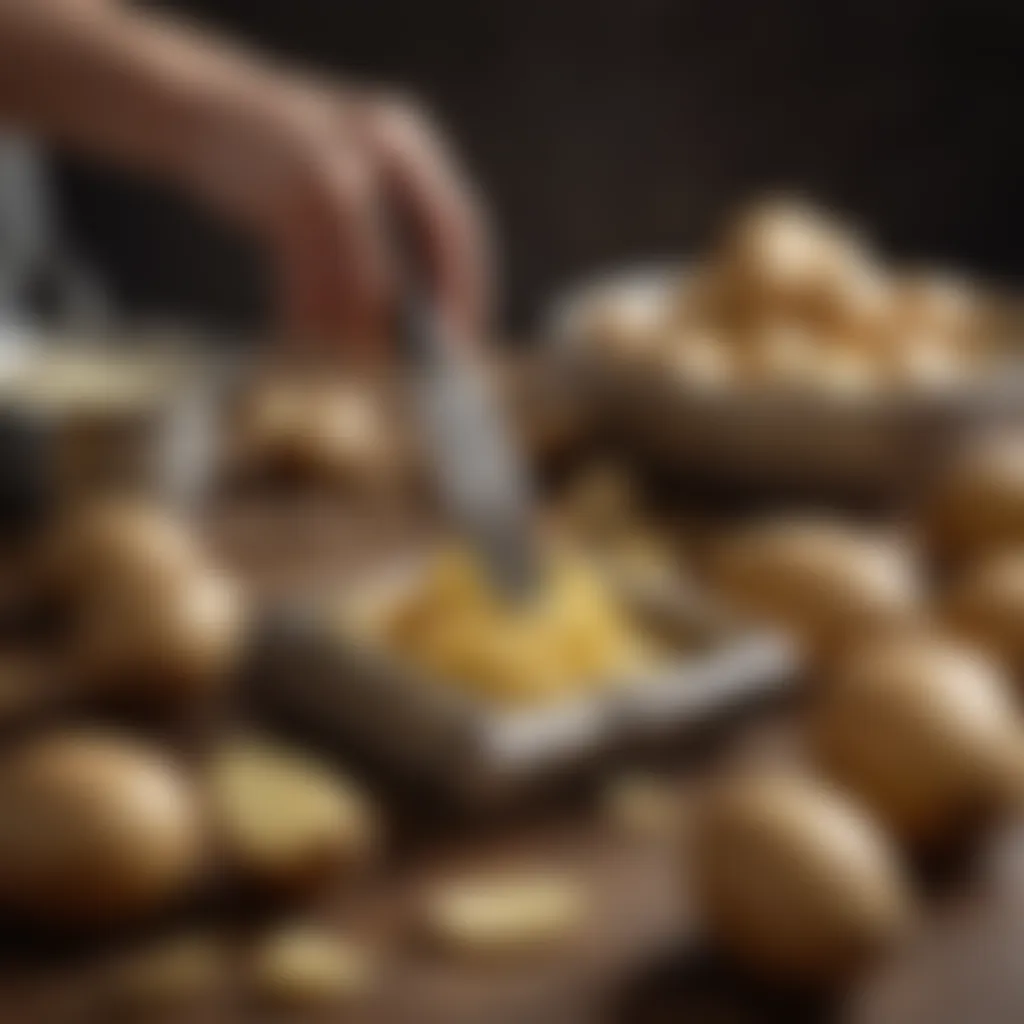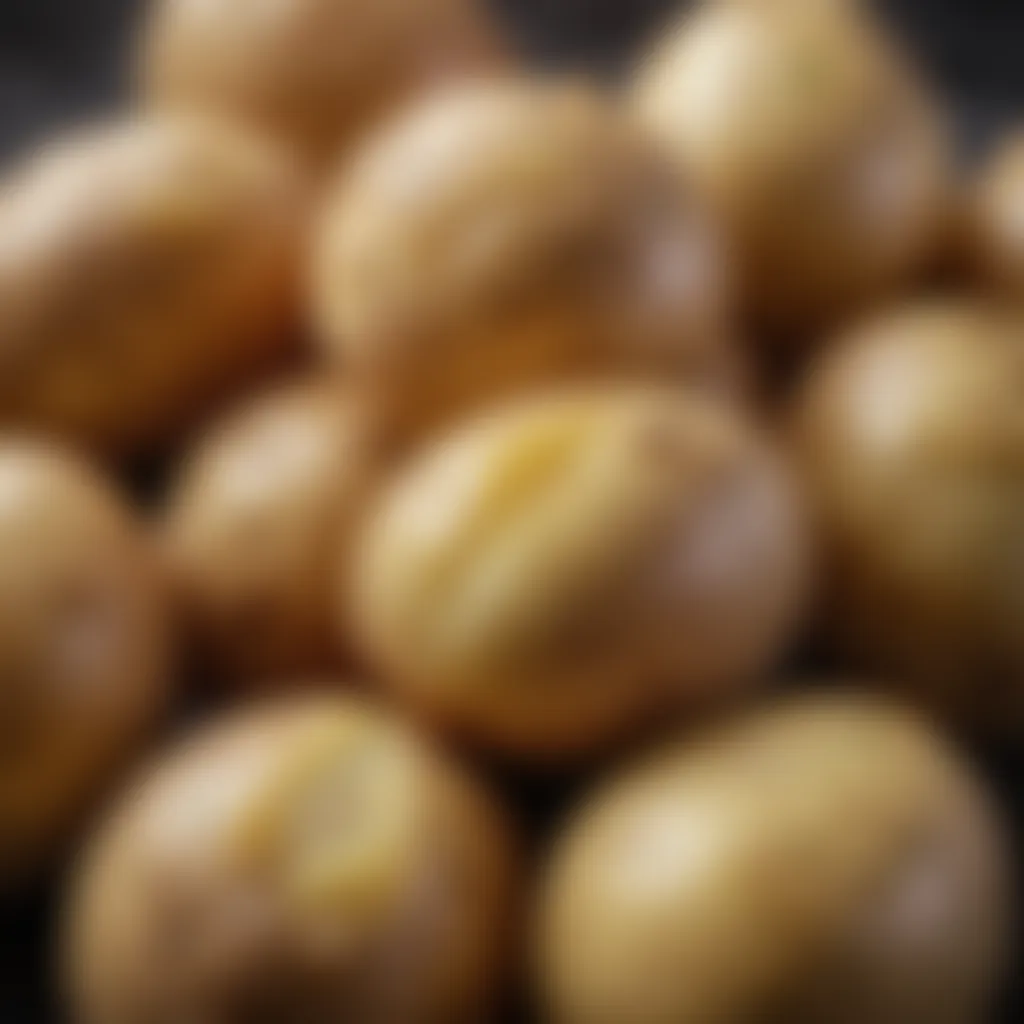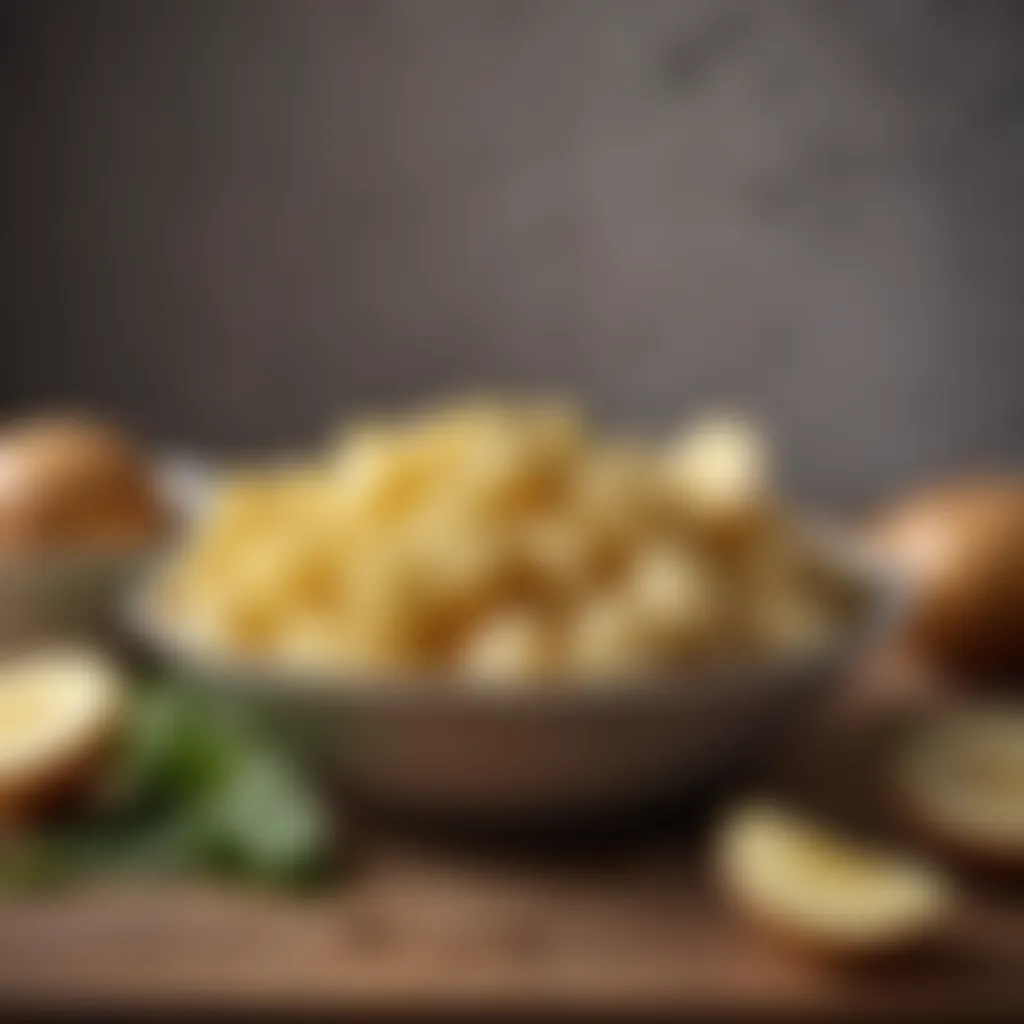To Peel or Not to Peel: The Potato Dilemma Explained


Intro
The humble potato, a staple found in kitchens around the globe, often sparks debate when it comes to its preparation. A seemingly simple decision like whether to peel or leave the skin on can lead to varying opinions steeped in culinary tradition, health considerations, and personal preference. This article aims to unpack this complex concept and help readers navigate the intricate world of potato preparation.
Understanding what goes into that choice isn't just about aesthetics or ease; it involves looking deeply into nutritional value, flavor enhancement, and cooking methods. Let’s step into the kitchen with our potatoes and explore every aspect of this culinary conundrum.
Ingredients:
- Potatoes: 2 pounds (Yukon Gold or Russet recommended)
- Salt: 1 tablespoon (for boiling water)
- Butter: 4 tablespoons (for mashing)
- Milk or Cream: ½ cup (for mashing)
- Black Pepper: to taste
- Chives: 2 tablespoons (chopped, optional for garnish)
- Paprika: 1 teaspoon (optional for added flavor)
Detailed Instructions:
Preparation Steps:
- Select the Potatoes: Choose firm, unblemished potatoes for optimal flavor and texture.
- Wash Thoroughly: Under cold water, scrub the potatoes to remove any dirt or debris, especially if you plan to leave the skin on.
- Decide to Peel or Not: This is the crux of our dish. Peel if you seek a smoother mash or texture; leave the skin on for added nutrients and a rustic feel.
- Cut into Even Pieces: Chop the potatoes into even chunks, about 2-inch cubes, to ensure uniform cooking.
Technical Aspects:
- Boiling Temperature: Begin with cold water in a large pot over medium-high heat.
- Boil Time: Once boiling, reduce heat to maintain a gentle boil. Cook potatoes for 15-20 minutes until fork-tender.
Cooking Process:
- Salt the Water: As the water heats, add salt. This enhances the flavor as the potatoes absorb some of the brine.
- Add Potatoes: Gently lower potatoes into boiling water. Avoid splashing to keep the heat constant.
- Check Tenderness: After 15 minutes, check for doneness. A fork should slide in easily but not break apart the potato.
- Drain: Carefully drain potatoes in a colander and allow them to steam off for a few minutes.
- Mashing: Return the drained potatoes to the pot. Add butter and milk or cream. Mash until the desired creaminess is reached. Season with black pepper.
- Serve: For garnish, sprinkle with chopped chives and paprika for added visual appeal and flavor.
Troubleshooting Tips:
- Too Watery: If mashed potatoes are watery, cook them a bit further on low heat to evaporate excess moisture.
- Lumpy Texture: For a smoother consistency, use a potato ricer instead of a masher.
- Flavor Needs Improvement: If bland, consider adding more salt or a splash of garlic or onion powder to enhance the taste.
"Choosing whether to peel potatoes can affect the dish's final flavor, texture, and nutrition. Think thoughtfully about what you want to achieve!"
Foreword to the Potato Dilemma
The debate over whether to peel potatoes or leave them be is more than just a matter of taste; it’s a topic steeped in history, culture, and personal preference. This conundrum resonates with anyone who’s walked the fine line between health consciousness and culinary delight. The decision to peel or not is not merely about the act itself but rather it reflects broader conversations about nutrition, sustainability, and tradition in our kitchens.
In cooking, the potato stands out as a versatile player. Those who advocate for unpeeled potatoes often highlight the nutritional benefits of the skin, including fiber and essential minerals. On the flip side, some chefs swear by the smoothness of peeled potatoes, arguing that it elevates the texture of a dish. This section aims to unpack these elements, diving into not only the how but also the why behind this potato dilemma.
Historical Context of Potato Consumption
To truly understand the potato dilemma, one must first travel back in time to the origins of this humble tuber. Potatoes have been a staple since their domestication in South America around 7,000 years ago. Initially, they were an integral part of Andean culture, praised for their resilience in harsh environments. Early consumption often involved cooking them with the skin on, as this method preserved nutrients and added texture to meals.
Over the centuries, as the potato journeyed across continents, peeling became associated with refinement in some cultures. For instance, the aristocracy of 18th-century Europe viewed peeling as a way to showcase culinary prowess, often discarding what we now recognize as nutrient-rich skins. This shift reflects broader societal trends where the aesthetics of food often took precedence over nutritional benefits.
Cultural Variations in Potato Preparation
The way we approach potato preparation varies widely around the globe, and each culture brings its unique flair. For example, in Ireland, the traditional dishes like colcannon often use potatoes with skins on, integrating them into stews and casseroles. This method not only adds depth to the rustic flavors but also honors the historical reliance on whole, unprocessed ingredients.
In contrast, French cuisine is notable for its finesse, often favoring peeled potatoes for dishes like purée or pommes dauphine. The focus here is on achieving a silky texture, demonstrating how cultural norms can shape our perception of cooking techniques.
Meanwhile, in Asian cuisines, potatoes find their way into curries and stir-fries, usually left unpeeled, retaining their earthy flavor and nutritional value.
"The way we prepare potatoes often tells more about our culinary history than one might think."


This cultural lens provides us a richer appreciation of the potato, revealing how practices like peeling or leaving the skin on are deeply intertwined with identity, tradition, and gastronomical pride.
As we march further into the article, we will unravel these dimensions more systematically, inviting you to question and explore your potato preferences with renewed awareness.
Nutritional Profile of Potatoes
Understanding the nutritional profile of potatoes is vital when considering whether to peel or not. Potatoes are often seen as mere comfort food; however, they pack a nutritional punch that many may not be aware of. Beyond just filling your stomach, potatoes can contribute to your overall health if prepared thoughtfully. This section will shed light on the key vitamins and minerals that potatoes offer and highlight how peeling them can affect nutrient content.
Vitamins and Minerals Found in Potatoes
Potatoes are a treasure trove of essential nutrients. They are rich in several vitamins and minerals which play crucial roles in bodily functions. Notably, these include:
- Vitamin C: This powerful antioxidant helps with immune function and skin health.
- Vitamin B6: It assists in metabolism and the production of neurotransmitters.
- Potassium: This mineral helps regulate blood pressure and supports proper muscle and nerve function.
- Iron: Important for blood health, iron helps transport oxygen in the body.
The skin of the potato is particularly high in many of these nutrients. When you discard the skin, you might be throwing away a significant portion of the health benefits.
"Leave the skin on, and you might just leave your doctor out of it."
Comparison of Nutrients in Skin Versus Flesh
A deep dive into the nutritional content of potato skin shows that it often rivals or surpasses that of the flesh. Here's a breakdown:
- Fiber: Potato skin contains notably more fiber than the flesh, which is vital for digestive health. For instance, the skin contributes about 2 grams of fiber, while the flesh provides around 1 gram. This makes the skin a worthwhile addition if you're looking to up your fiber intake.
- Antioxidants: The skin is where most of the antioxidants are found. One study indicated that the skin can contain up to 10 times more antioxidants than the flesh. This suggests that peeling might strip away valuable defense against oxidative stress.
- Nutrient Density: When comparing weight-for-weight, the skins often offer a more concentrated source of vitamins and minerals. This means that if you're aiming for a nutrient-dense meal, keeping the skin intact is advantageous.
In summary, whether you're preparing a comforting bowl of mashed potatoes or a crispy batch of fries, the choice of peeling or not profoundly impacts the nutritional benefits you could be gaining. Embracing whole potatoes may not only elevate your dish's flavor but also contribute further to your well-being.
The Culinary Perspective
When diving into the world of cooking, the decision to peel potatoes or leave their skin on isn't just a matter of preference; it’s a deep-rooted culinary debate that reflects tradition, taste, and even health. The culinary perspective encompasses a variety of aspects that round up the potato preparation conundrum. The methods by which we approach potatoes—whether with skin intact or peels removed—can drastically alter the outcome of a dish.
Flavor Profiles: Skin On Versus Skin Off
Flavor is one of the most persuasive reasons for deciding whether or not to peel. Potatoes hold a unique places in our kitchens, each variety possessing its own distinct flavor profile. With the skin on, potatoes tend to maintain a more earthy and rustic flavor, which can enhance dishes like roasted potatoes or rustic mashed variations. The skins, especially when cooked, allow for a delightful contrast of textures—crisp on the outside, soft within.
In contrast, peeled potatoes often yield a milder, creamier taste, making them ideal for dishes where a smooth texture is desired. Think creamy potato soup or fluffy mashed potatoes without the distraction of the skin’s chewiness. So, when making a choice, consider the intent behind your dish: do you want that robust earthiness or a smoother, more delicate flavor?
Texture Considerations in Cooking Methods
Texture can be a game changer in cooking. When the skin is left intact, it not only affects flavor but also alters the textural experience of the dish. For instance, when roasted, potatoes with skin often develop a crisp, delightful crust while remaining soft inside. This added crunch can elevate simple dishes, giving them a satisfying bite.
On the flip side, peeled potatoes tend to absorb liquid more effectively, which can be beneficial for dishes that require creaminess. In ways such as these, the textural differences become a key consideration: will your dish celebrate the contrast of textures, or will it lean into a softer, creamier finish? The answer lies in your culinary goal, and the method you choose will prominently influence the customer satisfaction.
Aesthetic Factors in Presentation
Presentation is another crucial element in cooking. The look of a dish can be as important as its taste. Potatoes dressed in their rustic skin often present a more homey vibe; they might evoke comfort and nostalgia — great for gatherings or family meals. Conversely, peeled potatoes lend a more polished look, which may be preferable in a fine dining setting.
For example, a plated dish that showcases skin-on potatoes can create a ‘farm to table’ aesthetic, highlighting simplicity and nourishment. Conversely, dishes using peeled potatoes might be arranged with finesse, focusing on cleanliness and elegance.
Ultimately, deciding whether to peel or not can have far-reaching implications: from flavor and texture to the overall appearance. It’s not merely about kitchen convenience; it’s about crafting an experience, all with the humble potato as the centerpiece.
"The beauty of cooking lies not only in the taste but also in its presentation, using ingredients that whisper their stories and traditions."


As housewives or cooks, understanding these various elements allows for more meaningful choices in the kitchen, leading to dishes that resonate far beyond the plate.
Health Implications
When it comes to the potato dilemma, the health implications of whether to peel or not seize a significant portion of the discussion. As potatoes are a staple in many diets around the world, understanding the health benefits or drawbacks of consuming skin-on versus peeled potatoes is crucial.
Fiber Content: Whole Potatoes vs. Peeled
Fiber plays a fundamental role in maintaining digestive health, and when comparing whole potatoes to their peeled counterparts, the discrepancy is quite noticeable. The skin of a potato is where a bulk of its fiber resides. When you opt to peel your potato, you’re essentially stripping away this beneficial component.
Research suggests that a medium-sized potato with skin can provide up to 4 grams of dietary fiber, while a peeled version offers roughly 2 grams. The difference might not sound dramatic, but every bit counts when aiming to meet the recommended daily intake of fiber. Many experts advocate for fiber-rich diets, as they can aid in preventing digestive issues, regulating blood sugar levels, and even reducing the risk of certain chronic diseases.
- Benefits of Fiber:
- Promotes digestive health
- Helps in controlling blood sugar levels
- Reduces cholesterol levels
“You can think of fiber as nature’s broom, sweeping through your system and keeping everything running smoothly.”
In essence, consuming whole potatoes means giving your body a helping of this essential nutrient, which can be a deciding factor in whether to peel or not.
Impact on Glycemic Index
Another significant aspect to consider is how peeling a potato can affect its glycemic index (GI). The glycemic index assigns a value based on how quickly carbohydrates from food raise blood sugar levels. Generally speaking, foods with a high GI can cause rapid spikes in blood sugar, whereas those with a lower GI provide more stable energy.
Potato skins contribute to a lower GI. While not a complete solution for blood sugar control, the fiber and additional nutrients within the skin slow down the digestion process, leading to a slower release of glucose into the bloodstream.
- Potato Variety Considerations:
- Red Potatoes: Typically low in GI when eaten with skin
- Sweet Potatoes: Generally lower GI across the board
In choosing to keep the skin on, you're not just making a culinary decision; you're potentially influencing your metabolic health. Low GI foods can be beneficial for managing weight and improving long-term health.
Potential Risks Associated with Consumed Peels
Despite the advantages, it’s also vital to address possible risks linked to consuming potato skins. Pesticide residue is one concern, as conventionally grown potatoes may be treated with substances that land on their skins. Washing thoroughly can help mitigate this, but some even prefer to choose organic potatoes when cooking with skin.
Another risk worth mentioning is the presence of solanine, a natural toxin found in potatoes that can concentrate near the skin. In rare cases, consuming green or sprouted potatoes can lead to food poisoning. This is why it's often recommended to inspect potatoes before cooking, ensuring they are free from green patches or undesirable sprouts. If you see any, peeling them may be a wise course of action.
- Safety Tips:
- Always wash potatoes thoroughly
- Inspect for green patches and sprouting
- Opt for organic when possible, to minimize pesticide exposure
In summary, while there are notable health benefits when you forgo peeling your potatoes, one must also be aware of the potential risks. Balancing these aspects can lead to a more informed decision, ultimately swaying you toward what works best for your health and culinary preferences.
Practical Considerations
Practical considerations play a critical role in determining whether one should peel potatoes before cooking or allow their skins to remain. These elements transcend mere preference and tap into the realms of efficiency, cost-effectiveness, and waste management. Given the commonplace nature of potatoes in countless diets around the world, understanding the nuances of preparation can lead to better meal planning and a more sustainable kitchen environment. In essence, the decision regarding skin care involves questioning not only the nutritional benefits but also the practical impact on daily life.
Time Efficiency in Meal Preparation
When timing is of the essence, the peeling of potatoes can feel like a necessary but time-consuming chore. For busy individuals and families, saving even a few minutes can have a ripple effect on meal times. Keeping the skin on can streamline the cooking process. For those who prefer a quick approach, scrubbing potatoes well can provide a clean result without sacrificing the nutritional benefits that the skin offers.


Moreover, methods like roasting, steaming, or simmering can be performed on unpeeled potatoes, often resulting in simpler meal prep. During times when you're short on time, cooking whole potatoes can allow one to focus on preparing other ingredients concurrently, maximizing efficiency in the kitchen.
One might say:
"Time is money, and in the kitchen, every second counts!"
In practical terms, consider the following:
- Multitasking: Cooking unpeeled potatoes means you can focus on other components of a meal without making extra steps.
- Reduced Cleanup: Without peels dumped in the trash or compost, it can lead to faster cleanup.
- Versatility in Cooking: Skin-on potatoes can be prepared in various dishes, including salads and casseroles, allowing for less planning.
Cost Considerations: Waste vs. Value
The economic aspect of preparing potatoes is paramount. When contemplating whether to peel or not, one should account for the financial implications of food waste. The skins of potatoes are often dismissed as inedible rubbish, yet they are a reservoir of nutrients and flavor. Considering the impact on a household budget can lead to significant savings over time. If one consistently tosses out potato peels, this could accumulate to a notable waste, both in cash and resources.
Key points of consideration include:
- Utilizing the Whole Food: Keeping the skin on maximizes the edible portions of the potato, leading to more total servings per pound.
- Cost Efficiency in Purchases: Investing in unpeeled, whole potatoes often presents a lower price per pound than pre-peeled or packaged alternatives.
- Sustainability Aspect: Reducing food waste aligns with sustainable practices, promoting conscientious use of resources.
Environmental Considerations
In today's world, where the conversation swings heavily towards sustainability and reducing our carbon footprint, potatoes present a surprisingly rich topic of discussion in relation to environmental considerations. This section examines how the choice to peel or not peel potatoes can subtly impact our ecological footprint, arguing for a more thoughtful alignment with whole food practices and careful kitchen management.
Sustainability of Whole Food Practices
When we think about sustainability, we often think of recycling or energy-efficient appliances, but what about the food we consume? Choosing to utilize the entire potato, skin and all, is a step towards more sustainable eating. The potato’s skin, while often discarded, is not just edible but also rich in nutrients. Keeping the skin aligns with the ethos of reducing waste in our kitchens, a fundamental pillar of sustainable food practices.
Imagine walking through your local market, entering a potato stand, and noticing bags labeled as "whole potatoes". These whole potatoes, with their skins still on, promote a lesser waste mindset. By opting for whole potatoes, consumers encourage growers to keep their farming practices inclusive of the entire vegetable, ensuring that they remain profitable all while providing minimal waste.
- Nutritional Value: The skin contains antioxidants and vitamins that can contribute toward a balanced diet.
- Reduced Waste: By keeping the skin on, less food waste is generated in homes, aligning with the principle of using all parts of a vegetable.
- Green Initiative: Making conscious decisions about food can influence others within a community to follow suit, creating a ripple effect.
Reducing Kitchen Waste Through Utilization
Kitchen waste is a significant issue that deserves our attention; in fact, food waste accounts for nearly 30-40% of the food supply globally. At a glance, peeling potatoes may seem trivial, but the metaphorical snowball effect of such decisions can spiral into larger environmental implications.
Shrinking waste begins with something as simple as leaving the skin on. When a potato is peeled, what is thrown away? Much more than just a layer of skin; it's also potential nutrients, flavor, and a portion of the overall vegetable. Here are a few insights on how to reduce kitchen waste:
- Creative Utilization: Potato skins can be used in multiple ways. From crispy snacks made by baking or frying to being tossed into stocks for added flavor, their utility is vast.
- Composting: If you still decide to peel, those skins can go straight into your compost bin, providing nourishment back to the earth rather than ending up in a landfill. This supports nutrient cycling which is key to sustainable gardening practices.
- Mindful Cooking: Consider preparing meals that take advantage of the whole potato. This can be a family activity that educates members about food and waste reduction.
By choosing to peel less and utilize more, not only are we making a deliciously satisfying choice but also one that respects our environment.
Culmination: The Enduring Potato Debate
The discussion about whether to peel potatoes or not stretches beyond mere kitchen habits; it's a reflection of our values around cooking, health, and sustainability. Each perspective highlights crucial elements that can affect one’s approach in the kitchen. For instance, peeling potatoes is often viewed as a way to ensure a certain texture or aesthetic for a dish. Nevertheless, keeping the skins intact often means tapping into a treasure trove of nutrients and fiber, which should not be overlooked. The choices made here resonate on personal, cultural, and environmental levels, making the potato dilemma truly enduring.
Final Thoughts on the Decision to Peel or Not
When it comes down to it, the decision of whether or not to peel your potatoes is beautifully subjective. Understanding that skins hold vitamins and minerals gives a strong lean towards keeping them on. However, some dishes—like creamy mashed potatoes or elegant potato purée—might demand the smoother texture that only peeling can provide.
In the end, it boils down to your preferences, the specific dish in mind, and perhaps the memories tied to your cooking. As you stand in the kitchen, consider this: if you peel, you might get a perfect mash, but if you don’t, you are embracing the straightforward, wholesome goodness that Mother Nature intended. Every potato tells a story, and the choice of skin or no skin is a chapter in your culinary adventure.
Encouraging Personal Preference and Experimentation
Cooking is an art, and like any artist, you should feel free to experiment and take risks. Each time you cook with potatoes, allow yourself the flexibility to try different approaches. Why not have a peeling night with friends and compare the taste of a skin-on potato dish to one that’s peeled? Introduce variations based on the type of cuisine you're exploring, from rustic stews to fine dining.
Engaging your family in this discussion can also provide unexpected insights. Kids may delight in the colorful skins, while adults could have a plethora of opinions shaped by their upbringing.
In short, let your kitchen be a laboratory of flavors. Play around with the skins, charting how the taste and texture shifts each time. Remember to keep an open mind, and above all, find joy in the process. As you navigate these culinary waters, the potato dilemma can lead to delightful discoveries and hearty meals.







